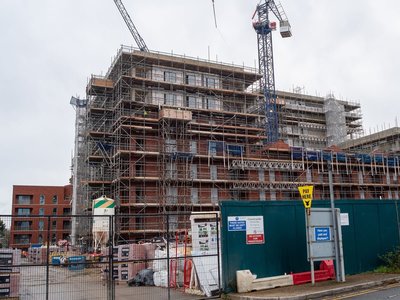
Government Launches Plan to Tackle NHS Waiting List Backlog
Aimed at reducing waiting times, the initiative introduces Community Diagnostic Centres, surgical hubs, and patient-focused reforms to ease NHS pressures.
The UK government has unveiled a comprehensive plan to reduce NHS waiting lists in England, targeting a reduction of nearly 500,000 patients waiting over 18 weeks for treatment by March 2026.
The initiative, announced on Monday, includes expanded access to Community Diagnostic Centres, new surgical hubs, and patient-focused reforms to improve efficiency and accessibility.
Key Measures to Reduce Waiting Times
The plan aims to achieve the longstanding NHS target of ensuring that 92% of patients begin treatment or receive a diagnosis within 18 weeks.
Currently, only 59% of patients meet this benchmark, with around three million people waiting longer.
The new target is to reach 65% by the end of March 2026.
Community Diagnostic Centres will play a central role, extending their hours to operate 12 hours a day, seven days a week.
These centres provide local appointments for tests such as scans and endoscopies, reducing reliance on hospitals and aiming to deliver an additional half a million appointments annually.
GPs will be able to refer patients directly to these centres without prior consultation with a senior doctor.
Surgical hubs will focus on common procedures, including cataract surgeries and some orthopaedic treatments.
These hubs, isolated from emergency services, ensure operating time is preserved for planned procedures.
Additionally, the government plans to eliminate unnecessary follow-up appointments, freeing up one million slots annually for patients who need them most.
Integration with Digital Tools
The NHS App will give patients greater control over their care, allowing them to book consultations, monitor test results, and choose treatment locations.
This digital integration is intended to reduce inefficiencies, such as missed appointments, and empower patients in managing their healthcare.
Broader Context and Reactions
Prime Minister Sir Keir Starmer highlighted the plan as a fulfillment of Labour’s election pledge to improve NHS services and end treatment backlogs.
"Greater choice and convenience for patients.
Staff once again able to give the standard of care they desperately want to," he said.
Amanda Pritchard, NHS England Chief Executive, praised the initiative, describing it as a significant reform that would boost capacity while empowering patients.
However, the British Medical Association (BMA) expressed skepticism about the plan’s feasibility.
Professor Phil Banfield, chair of the BMA Council, noted that workforce shortages remain a major barrier.
"Without the workforce to meet constantly rising demand, we will not see the progress we all hope for," he stated.
Shadow Health and Social Care Secretary Ed Argar criticized Labour’s approach, calling it a rebranding of Conservative-led initiatives, including the rollout of 160 Community Diagnostic Centres.
Liberal Democrat MP Helen Morgan warned that prioritizing elective surgeries might overlook crises in emergency and social care.
Funding and Implementation
The plan’s funding will align with NHS England’s existing budget, with additional financial requirements for expanded hospital activities to be outlined in the government’s forthcoming spending review.
As NHS waiting lists hover at 7.5 million, the plan represents a critical step in addressing long-standing issues in healthcare delivery.
Ministers emphasized that progress toward the 18-week benchmark would naturally reduce overall waiting times, but no specific target for waiting list reductions has been set.
With ambitious goals and significant structural changes, the government’s plan seeks to alleviate the strain on the NHS and improve healthcare access for millions of patients.
The initiative, announced on Monday, includes expanded access to Community Diagnostic Centres, new surgical hubs, and patient-focused reforms to improve efficiency and accessibility.
Key Measures to Reduce Waiting Times
The plan aims to achieve the longstanding NHS target of ensuring that 92% of patients begin treatment or receive a diagnosis within 18 weeks.
Currently, only 59% of patients meet this benchmark, with around three million people waiting longer.
The new target is to reach 65% by the end of March 2026.
Community Diagnostic Centres will play a central role, extending their hours to operate 12 hours a day, seven days a week.
These centres provide local appointments for tests such as scans and endoscopies, reducing reliance on hospitals and aiming to deliver an additional half a million appointments annually.
GPs will be able to refer patients directly to these centres without prior consultation with a senior doctor.
Surgical hubs will focus on common procedures, including cataract surgeries and some orthopaedic treatments.
These hubs, isolated from emergency services, ensure operating time is preserved for planned procedures.
Additionally, the government plans to eliminate unnecessary follow-up appointments, freeing up one million slots annually for patients who need them most.
Integration with Digital Tools
The NHS App will give patients greater control over their care, allowing them to book consultations, monitor test results, and choose treatment locations.
This digital integration is intended to reduce inefficiencies, such as missed appointments, and empower patients in managing their healthcare.
Broader Context and Reactions
Prime Minister Sir Keir Starmer highlighted the plan as a fulfillment of Labour’s election pledge to improve NHS services and end treatment backlogs.
"Greater choice and convenience for patients.
Staff once again able to give the standard of care they desperately want to," he said.
Amanda Pritchard, NHS England Chief Executive, praised the initiative, describing it as a significant reform that would boost capacity while empowering patients.
However, the British Medical Association (BMA) expressed skepticism about the plan’s feasibility.
Professor Phil Banfield, chair of the BMA Council, noted that workforce shortages remain a major barrier.
"Without the workforce to meet constantly rising demand, we will not see the progress we all hope for," he stated.
Shadow Health and Social Care Secretary Ed Argar criticized Labour’s approach, calling it a rebranding of Conservative-led initiatives, including the rollout of 160 Community Diagnostic Centres.
Liberal Democrat MP Helen Morgan warned that prioritizing elective surgeries might overlook crises in emergency and social care.
Funding and Implementation
The plan’s funding will align with NHS England’s existing budget, with additional financial requirements for expanded hospital activities to be outlined in the government’s forthcoming spending review.
As NHS waiting lists hover at 7.5 million, the plan represents a critical step in addressing long-standing issues in healthcare delivery.
Ministers emphasized that progress toward the 18-week benchmark would naturally reduce overall waiting times, but no specific target for waiting list reductions has been set.
With ambitious goals and significant structural changes, the government’s plan seeks to alleviate the strain on the NHS and improve healthcare access for millions of patients.










